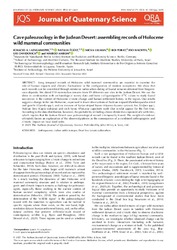Cave paleozoology in the Judean Desert: assembling records of Holocene wild mammal communities
Porat, Roi
DOI: https://doi.org/10.1002/jqs.3405
Persistent URL: http://resolver.sub.uni-goettingen.de/purl?gldocs-11858/9975
Persistent URL: http://resolver.sub.uni-goettingen.de/purl?gldocs-11858/9975
Lazagabaster, Ignacio A.; Égüez, Natalia; Ullman, Micka; Porat, Roi; Wachtel, Ido; Davidovich, Uri; Marom, Nimrod, 2021: Cave paleozoology in the Judean Desert: assembling records of Holocene wild mammal communities. In: Journal of Quaternary Science, Band 37, 4: 651 - 663, DOI: 10.1002/jqs.3405.
 |
Dokument öffnen: |
Long temporal records of Holocene wild mammal communities are essential to examine the role of human impacts and climatic fluctuations in the configuration of modern ecosystems. We show that such records can be assembled through extensive radiocarbon dating of faunal remains obtained from biogenic cave deposits. We dated 110 mammalian remains from 19 different cave sites in the Judean Desert. We use the dates in combination with archaeological survey data and bone collagen/apatite δ13C values to study faunal succession in the context of Holocene climate change and human settlement history in the region. Our results suggest a change in the late Holocene, expressed in fewer observations of Arabian leopard (Panthera pardus nimr) and gazelle (Gazella spp.), and an increase of Syrian striped hyena (Hyaena hyaena syriaca), fox (Vulpes spp.), Nubian ibex (Capra nubiana) and rock hyrax (Procavia capensis); suids (Sus scrofa) appear for the first time. According to the data distribution, however, the probability of finding a bone diminishes exponentially with time, which implies that the Judean Desert cave paleozoological record is temporally biased. The weight of evidence ultimately favors an explanation of the observed patterns as the consequence of a combined anthropogenic and climatic impact on local food webs.
Statistik:
ZugriffsstatistikSammlung:
This is an open access article under the terms of the Creative Commons Attribution License, which permits use, distribution and reproduction in any medium, provided the original work is properly cited.

